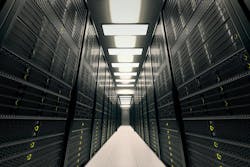Data centers have the potential to double their energy usage by 2026, according to a recent International Energy Agency (IEA) report.
IEC forecast that data centers’ total electricity consumption could reach more than 1,000 TWh in 2026.
“This demand is roughly equivalent to the electricity consumption of Japan,” said the report. “Updated regulations and technological improvements, including on efficiency, will be crucial to moderate the surge in energy consumption from data centers.”
In 2022, 460TWh was consumed by data centers, representing two percent of all global electricity usage. Within the data center segment, IEC wrote that computing power and cooling were the two most energy-intensive processes within data centers. Additionally, the rapid growth of artificial intelligence-related services over the last 12 months means providers have invested in power-hungry GPUs.
AI, cryptocurrencies influence
AI and cryptocurrencies, hosted inside data centers, are raising energy consumption. IEC said that artificial intelligence (AI) and cryptocurrency will double electricity usage by 2026.
What will drive AI’s usage trends is that as AI gets incorporated into software programming in various sectors, it will increase the overall electricity demand of data centers.
For example, the study forecasts that search engine sites like Google could witness a tenfold increase in electricity demand when AI is fully implemented on their platform.
“When comparing the average electricity demand of a typical Google search (0.3 Wh of electricity) to OpenAI’s ChatGPT (2.9 Wh per request), and considering 9 billion searches daily, this would require almost 10 TWh of additional electricity in a year," said the report. "AI electricity demand can be forecast more comprehensively based on the number of AI servers estimated to be sold and their rated power.”
NVIDIA continues to lead the AI server market, which has a 95% market share. Last year, NVIDIA shipped 100,000 units that consume an average of 7.3 TWh of electricity annually. IEC said that by 2026, the AI industry is expected to have grown exponentially to drink at least ten times its demand in 2023.
Cryptocurrencies consumed about 110 TWh of electricity in 2022, accounting for 0.4% of the global annual electricity demand. IEC forecast that the electricity consumption of cryptocurrencies will increase by more than 40% to around 160 TWh by 2026.
However, the study highlighted differences and technology efficiency challenges amongst the leading cryptocurrency platforms—Bitcoin and Ethereum. Ethereum reduced its electricity demand by 99% in 2022 by changing its mining mechanism, while Bitcoin is estimated to have consumed 120 TWh by 2023, contributing to a total cryptocurrency electricity demand of 130 TWh.
“Challenges in reducing electricity consumption remain, as energy savings can be offset by increases in other energy consuming operations, such as other cryptocurrencies, even as some become more efficient,” the study said.
US market to surge
From a regional perspective, IEC found over 8,000 data centers globally: 33% in the U.S., 16% in Europe, and almost 10% in China.
IEC estimates that the U.S. data center's electricity consumption rate will rise from about 200 TWh in 2022 to almost 260 TWh in 2026, accounting for 6% of total electricity demand. This growth will result from the ongoing adoption of 5G wireless networks, cloud-based services, and competitive state tax incentives.
California, Texas and Virginia have become the most significant data center markets. Virginia saw rapid data center growth in 2021, which attracted 62% of the state’s new investments and created over 5,000 new jobs. Northern Virginia is the largest US data center market, raking in $1 billion in local tax revenues annually. The market will grow further as Amazon proceeds with its $35 billion expansion plan by 2040.
However, the IEC study pointed out that new legislation will tighten regulations on data center developments, including zoning rules, mandatory environment and resource impact assessments, and guidelines on water usage.
Regional transmission organization (RTO) PJM expects data centers to drive new electricity demands. The summer peak load is forecasted to rise from 151 GW in 2024 to 178 GW by 2034.
For related articles, visit the Data Center Test Topic Center.
For more information on optical components and suppliers, visit the Lightwave Buyer’s Guide.
To stay abreast of optical communications technology, subscribe to Lightwave’s Enabling Technologies Newsletter.

